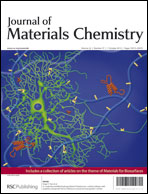SiAlON-based crystal–glass composite phosphor with tunable yellow-green-blue color emission induced by SiO2 melting corrosion
Abstract
SiAlON-based crystal–glass composite phosphors with tunable yellow-green-blue emission are exploited. Substitution of Al–N by Si–O in a SiAlON lattice and the introduction of a Si–Al–O–N glass phase are induced by melting corrosion as SiAlON polycrystal powders were heat-treated with nano-SiO2 additive. The melting corrosion process involving liquid penetration, solid dissolution, liquid transportation is discussed and assigned to the origin of morphology transformation. The substitution extent and the glass content are identified to increase with the addition of nano-SiO2 additive. The resultant tunable photoluminescence of Eu2+ in the SiAlON lattice and Si–Al–O–N glass


 Please wait while we load your content...
Please wait while we load your content...